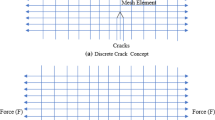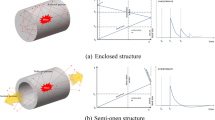In the course of combat operations, accidental projectile detonation in the mortar barrel channel can occur through the faulty fuze actuation or detonation of two projectiles for the violation of safety measures, viz double charging of the mortar. Barrel rupture occasions pose new challenges for the developers of this weapon to improve the safe operation of mortars. The literature analysis revealed that among the current studies on the stress-strain state of mortar barrels during the projectile explosion in their channel, the results of determining the stresses in the barrel structures capable of withstanding the explosive gas pressure in the channel were absent. Existing mathematical models for evaluating the stress-strain state of a mortar barrel on the projectile detonation in its channel need to be improved. The potentials of developing new approaches to mortar barrel strengthening for combat operations are substantiated. For this, the theory of insert liquid-filled cylinder structures (pipes) is proposed. The internal pressure for those structures is calculated. The mortar barrels can be modified by applying the optimum combination of new materials and modern design circuitry.



Similar content being viewed by others
References
P. E. Trofymenko, Fundamentals of Combat Use of an Artillery Battery [in Ukrainian], Sumy State University, Sumy (2022).
O. Ya. Grigorenko and L. S. Rozhok, “Stress state of non-thin elliptical cylindrical shells under a local longitudinal load,” Int Appl Mech, 59, No. 2, 153-165 (2023).
O. V. Marchuk, O. O. Raskazov, S. V. Gnedash, and S. A. Levkivskyi, “Stress strain behavior analysis of thick-walled anisotropic cylinder sheaths susceptible to local impact,” in: Strength of Materials and Theory of Structures [in Ukrainian], No. 94 (2015), pp. 172-185.
H. Bakaiyan, H. Hosseini, and E. Ameri, “Analysis of multi-layered filament-wound composite pipes under combined internal pressure and thermomechanical loading with thermal variations,” Compos Struct, 88, No. 4, 532-541 (2009).
A. Hosine, D. Chapelle, M. L. Baubakar, et al., “Experimental and analytical investigation of the cylindrical part of a metal vessel reinforced by filament winding while submitted to internal pressure,” Int J Pres Ves Pip, 86, 649-655 (2009).
H. Y. Sheng and J. Q. Ye, “A three-dimensional state space finite element solution for laminated composite cylindrical shells,” Comp Meth Appl Mech Eng, 192, 2441-2459 (2003).
A. I. Shuvalov and K. P. Soldatos, “On the successive approximation method for three-dimensional analysis of radically inhomogeneous tubes with an arbitrary cylindrical anisotropy,” J Sound Vib, 259, No. 1, 233-239 (2003).
N. A. Tkachuk A. V. Martynenko, A. V. Grabovskii, and A. Yu. Vasiliev, “Analysis of dynamic processes and stress-strain state of artillery barrels,” Bull National Techn Univ “KhPI”, No. 23, 147-153 (2013).
V. G. Sufianov, “Mathematical modeling of stress-strain state of gun barrel at shot,” Intellekt Sistem Proizv, No. 3, 13-17 (2016).
I. B. Chepkov, M. I. Vaskivskyi, S. P. Bisyk, et al., “Research of blast mines in the barrel 120 mm mortar,” Weapons and Military Equipment [in Ukrainian], 14, No. 2, 23-28 (2017).
Yu. N. Bardachev and Y. G. Rozov, “Development of the design and computational methods for small arm barrels with finite element simulation,” Bull Kherson National Techn Univ, No. 4, 23-30 (2015).
S. O. Piskunov, I. I. Solodei, Yu. V. Maksimyuk, and A. D. Solodenko, “Features of application of moment finite element scheme (MSSE) for linear calculations of plates and shells,” in: Strength of Materials and Theory of Structures [in Ukrainian], No. 91 (2013), pp. 59-75.
V. I. Zayarnyi, Fundamentals of the Theory of Combined Vessels [in Russian], Lvov University Press, Lvov (1972).
G. S. Pisarenko, A. P. Yakovlev, and V. V. Matveev, Strength of Materials Handbook [in Russian], Delta, Kiev (2008).
A. G. Dibir, O. V. Makarov, N. I. Pekelnyi, et al., Practical Strength Calculations of Structural Elements [in Russian], Natl. Aerospace University “Kharkov Aviation Institute”, Kharkov (2007).
V. N. Syrykh and K. M. Karpets, “Assessment of the emergency causes of an IGNIS-500 solid fuel boiler explosion,” in: Problems of Emergencies [in Ukrainian], Issue 21, Kharkiv (2015), pp. 107-111.
M. I. Tulepov and Y. V. Kazakov, Gunpowder and Explosives [in Russian], Kazak University, Almaty (2014).
Author information
Authors and Affiliations
Corresponding author
Additional information
Translated from Problemy Mitsnosti, No. 6, p. 81 – 91, November – December, 2023.
Rights and permissions
Springer Nature or its licensor (e.g. a society or other partner) holds exclusive rights to this article under a publishing agreement with the author(s) or other rightsholder(s); author self-archiving of the accepted manuscript version of this article is solely governed by the terms of such publishing agreement and applicable law.
About this article
Cite this article
Kovtun, A.V., Tabunenko, V.O. & Nesterenko, S.I. Insert Cylinder Structures for Mortar Barrel Strengthening. Strength Mater (2024). https://doi.org/10.1007/s11223-024-00606-y
Received:
Published:
DOI: https://doi.org/10.1007/s11223-024-00606-y




